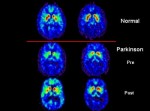The addition of subthalamic stimulation to medication therapy not only improved the quality of life of patients with early Parkinson’s disease and mild levodopa-induced motor complications but also reduced their subsequent motor disability in a randomized trial conducted in French and German centers.
The combination is already known to help advanced Parkinson’s patients. The new findings suggest that “neurostimulation may be a therapeutic option for patients at an earlier stage than current recommendations suggest,” wrote lead author Dr. W.M.M. Schüpbach and coinvestigators in the EARLYSTIM (Controlled Trial of Deep-Brain Stimulation in Early Patients with Parkinson’s Disease) study group (N. Engl. J. Med. 2013;368:610-22 [doi:10.1056/NEJMoa1205158]).
The investigators randomized 127 patients with early motor complications to best-practices drug therapy and 124 to that plus subthalamic neurostimulation.
At the end of 2 years, the combination group reported a 7.8 point quality-of-life improvement on the 100-point Parkinson’s Disease [self-] Questionnaire (PDQ-39) summary index, the study’s primary outcome; medication-only patients reported a 0.2 point drop. The between-group difference in mean change from baseline to 2 years was 8.0 points (P = .002).
The neurostimulation group had better scores on motor disability, too, with a between-group difference on the 70-point Unified Parkinson’s Disease Rating Scale (UPDRS), Part III, of 16.4 points without medication in favor of neurostimulation (P less than .001). Neurostimulation was also modestly superior on activities of daily living (P less than .001) and levodopa-induced motor complications (P less than .001), both also assessed by their appropriate UPDRS sections. The group that received neurostimulation also reported longer times with good mobility and no dyskinesia, as reported in patient diaries (P = .01). Stimulation patients had a 39% reduction in their levodopa-equivalent daily dosages, while drug-only patients had an increase of about 21%.
“Because motor symptoms and quality of life” remained relatively constant in the drug-only group, “the improvement among patients who underwent surgical implantation can be attributed to neurostimulation,” wrote the authors of the study, which was funded in part by Medtronic, the manufacturer of the neurostimulation equipment used in the trial.
There were no significant between-group differences at baseline. Patients in both groups were about 52 years old on average, sick for about 7.5 years, and on levodopa for about 5 years. They had levodopa-induced motor complications for an average of about 18 months. Overall, study subjects were a bit younger and less ill than in previous neurostimulation trials, according to the authors.
Sixty-eight patients (55%) in the combination group had serious adverse events; there were 26 serious problems related to the surgery or device, including a brain abscess, but they healed with treatment. Major depression was also more common in the neurostimulation group.
Serious adverse events were noted in 56 of the drug-only subjects (44%), most of which were the result of motor problems and medication side-effects such as impulse control and hallucinations. Those patients made more office visits for health problems, too.
Two patients in the neurostimulation group and one in the medication-only group committed suicide; two in each group made an attempt.
“We hypothesize that the decision to eventually undergo neurostimulation may select a specific subgroup of patients with a higher risk for suicidal behavior than the general population,” the researchers wrote.
Neurostimulation patients had bilateral stereotactic surgery, with the implantation of electrodes (model 3389, Medtronic) and a pulse generator (Kinetra or Soletra, Medtronic). Stimulation was similar in both hemispheres, with a mean strength of 2.8 V, mean stimulation frequency of 142 Hz, and mean pulse duration of 66 microseconds. Stimulation took about 5 months to reach its maximum benefit.
All but 1 of the 50 investigators disclosed some form of financial relationship with Medtronic, including grants, travel funding, and speaker, consultant, data review, and educational-material development fees. One is a Medtronic board member. Part of the lead investigator’s institutional salary is paid by the company. In addition to Medtronic, the German Ministry of Research and the French Programme Hospitalier de Recherche Clinique National helped fund the study.


0 Comments